
A long time ago, in a distant galaxy, video game developers concentrated their efforts on addictive gameplay, were not afraid to experiment, coming up with new features and even entire genres, and sought to create not just commercial products, but holistic, harmonious works of art, each of which was unique in its own way ... Alas, the golden age of the gaming industry has long passed: today even other AAA projects most of all resemble online casinos in a beautiful wrapper, offering a whole bunch of addictive mechanics and unable to surprise you with anything other than prices in the in-game store.
Fortunately, thanks to game console emulators, you and I can return to those wonderful times when creators ruled the show, not effective managers, and games aimed to entertain the player and bring true joy. But how legal is the use of such programs and is it not a form of piracy? Let's try to figure it out together.
From IBM System / 360 to iNES
Since it all starts with an idea, we can say that we owe the emergence of emulators to IBM, which is the main trendsetter in the world of information technology. The release back in 1964 of the IBM System / 360 series of mainframes marked the beginning of a new era, because it was in these computers that a clear boundary between architecture and implementation was first drawn, which was made possible by the use of microcode that provided interaction between the central processor and software.

Mainframe IBM System / 360
A new level of abstraction made it possible to use identical software on all devices in the series (with the exception of a few highly specialized modifications), ranging from budgetary solutions to high-performance solutions that were almost 50 times faster than the entry-level model, which opened up additional opportunities for the end user ... The company was now able to purchase equipment that meets its current needs and migrate as it grows to more powerful platforms without the need to modify existing software, which helped to significantly reduce the financial and time costs of modernizing IT infrastructure.
With the light hand of IBM, the use of software and / or hardware designed to copy the functions of one computing system (guest) to another (host) became known as emulation. The invention of emulation determined the general vector of development of the entire computer industry for many years to come, and subsequently brought a lot of joy to fans of video games, because according to the Hamburg account, it is thanks to IBM innovations that today we can return to the past and enjoy our favorite toys that came out several decades ago.
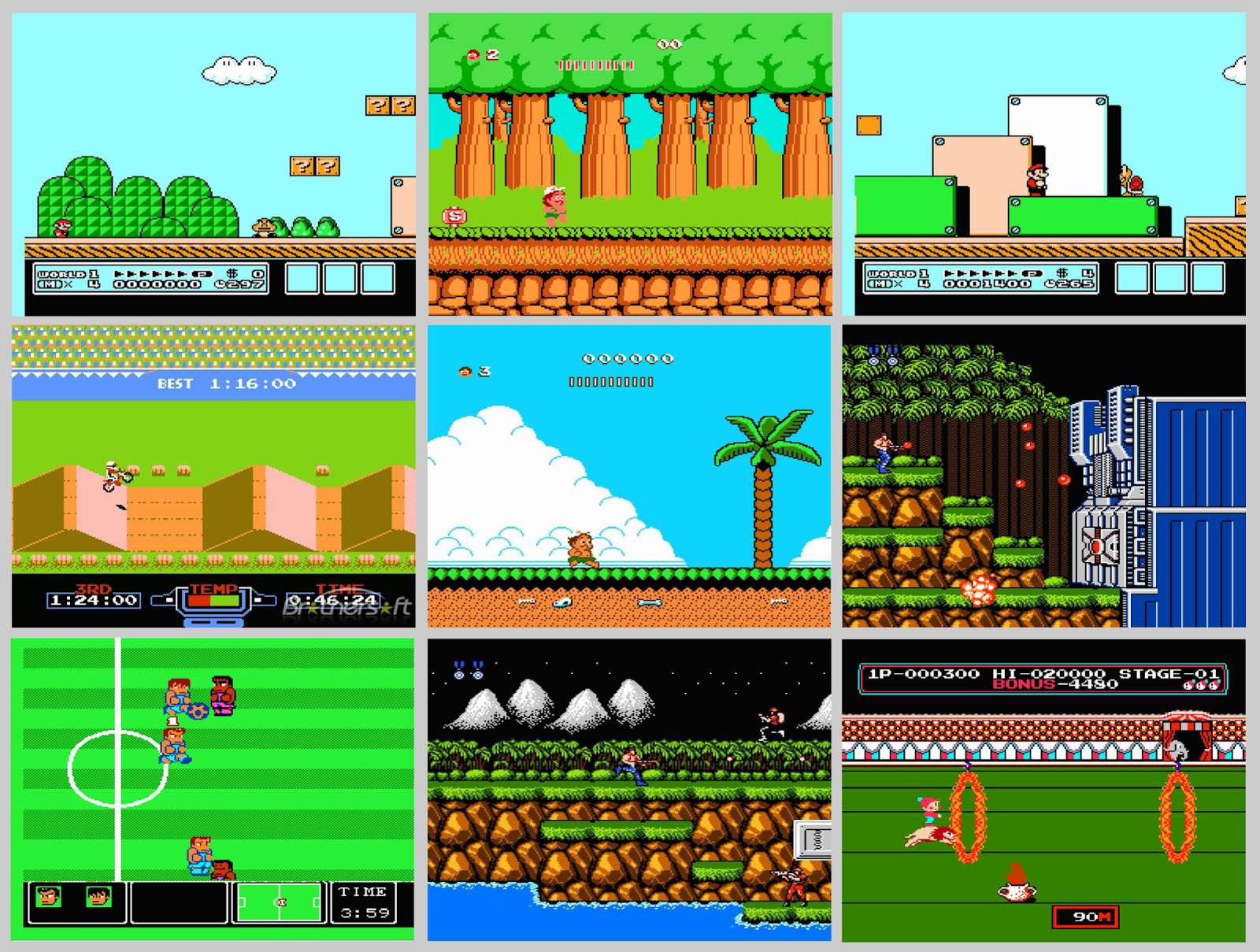
Interest in the creation of emulators for gaming systems appeared in the developer community in the 90s of the last century, when the performance of personal computers reached a sufficient level to reproduce the behavior of consoles at an acceptable speed. A great contribution to the development of this direction was made by our former compatriot, a native of Perm, Marat Fayzullin, better known in the network under the nickname fms, who emigrated to the United States in 1992. The future holder of a doctorate in computer science from the University of Maryland at College Park, who later joined Intel as a Senior Software Engineer, became widely known among video game fans thanks to the development of the MSX (Machines with Software eXchangeability) platform emulator - fMSX, the first version of which was published in 1993,and also thanks to the projects Virtual Game Boy (VGB, 1995) and Virtual Game Boy Advance (VGBA), designed to run games released on the Nintendo portable consoles of the same name, and the development of one of the very first (and most successful) Nintendo Entertainment System emulators - iNES, which was released in 1996.

The listed projects continue to develop to this day and are available on almost all current platforms. And the emulation code for the eight-bit MOS Technology 6502 processor, written by Faizullin, turned out to be so successful that it was later used in the development of xNES, created by Nicholas Hamel, FreeNES from Samuel Bronson, NES and PCEngine emulator from Bero, and many other projects.
First Bleem! lumpy
Although, for obvious reasons, it was the Nintendo consoles that enjoyed special love among emulator developers, the first litigation in this area was not initiated by "Big N", but by Sony, which filed a lawsuit in 2000 against Connectix Corporation, the author of Bleem! - an emulator of the PlayStation game system.

Boxed Edition of Bleem! for Windows 95/98
Taking into account the fact that the PlayStation 2 premiered in Japan in the spring of the same year, and in the fall the console began to be sold in the US and the European Union, such a step looks, to put it mildly, strange. Nevertheless, Sony had three compelling reasons for litigation:
- Bleem! turned out to be really fast
Bleem! was written in assembler and, unlike many other emulators of that time, using exclusively the processing power of the CPU, was able to work with graphics accelerators, which made it possible to play Sony exclusives even on relatively weak machines. For the Japanese giant, this could become a serious problem, because on June 7, 2000, at the end of a generation, an updated version of the PlayStation - PSone, was released, and the emulator available to a wide range of consumers could negatively affect its sales.
- The emulator worked on Sega Dreamcast
Bleemcast project! allowed to run games from the first PlayStation on the console of a direct competitor - Sega Dreamcast. To do this, Connectix Corporation exploited a vulnerability in the MIL-CD (Music Interactive Live CD) standard created by Sega to play multimedia discs on a home console. And Bleemcast! did not just emulate the Sony console, but significantly improved the graphics in the games being launched, increasing the render resolution to 640 × 480 pixels, that is, exactly twice (on PS1 the games worked at 320 × 240), adding anti-aliasing and bilinear filtering of textures.

CD-ROM cover with Bleem! for Sega Dreamcast game console
- Bleem! was a commercial product
Connectix Corporation developed Bleem! Not for altruistic reasons or for donations from grateful fans: both the original emulator and Bleemcast! were sold on physical media. As there was profit-making, this allowed Sony to initiate legal proceedings.
And oddly enough, the Japanese giant lost on all fronts, and this process created a very important judicial precedent. Based on its results, the court decided that the creation of emulators and even their commercial implementation did not violate the Berne Convention (the main international agreement in the field of copyright) and did not contradict local legislation. But only if the original code was written and all the information about the architecture necessary for development was obtained by reverse engineering, and not from the internal documentation of the platform holder, which came into the public domain as a result of leaks or was stolen deliberately.
Nevertheless, for Connectix Corporation itself, the victory was Pyrrhic. During the litigation, the case went through several instances, and although in the end the decision was made in favor of the Bleem! Developers, the small company simply could not cope with the huge costs. The situation was complicated by the termination of the Dreamcast in North America, which Sega announced in 2001, so all work on Bleemcast! (and in the end the developers had to adapt the emulator for each specific game) turned out to be meaningless.
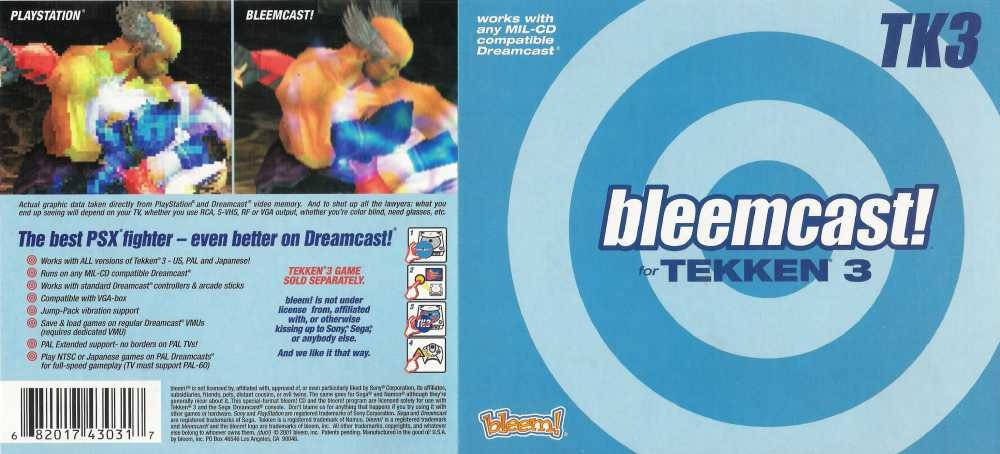
Bleemcast cover! for Tekken 3
As a result, in November 2001, Connectix Corporation announced the closure of Bleem! A splash screen appeared on the project's official website, depicting a tombstone with the name of the emulator and Sonic the hedgehog sobbing over it, clutching a drooping flower in his hand (a reference to the Sega console, the success of which the developers hoped most).

Rest in peace, Bleem! ..
The tale of how cheaters sued Nintendo
You can argue as much as you like who is right and who is to blame for the Bleem! Story, but the enormous significance of this incident cannot be denied. In many ways, it was the legal confrontation between Sony and Connectix Corporation that discouraged large companies from any desire to sue the developers of game system emulators. In particular, this opinion is shared by Pierre Bourdon, one of the creators of Dolphin, an open source Wii and GameCube emulator.
As a reminder, The Legend of Zelda: Ocarina of Time for the GameCube was released on May 3, 2003, and Dolphin was able to launch this game just a week after its release. And even if this was not a new part of the series, but only a port with Nintendo64, the leak of "the best video game in the history of the industry”, And to this day having the highest score on Metacritic among all the ranked projects, could not hide from the vigilant gaze of the lawyers of“ big N ”. Moreover, when launched on the emulator, the game looked much better than on the original console.

The Legend of Zelda: Ocarina of Time
However, Nintendo simply had nothing to cling to. Dolphin's source code was initially available for comprehensive analysis, and none of its lines were subject to copyright laws or the company's own licensing agreements for non-disclosure of technical data constituting trade secrets. It was transparency that allowed Dolphin to avoid a sad fate.
Another slippery point regarding both the development and use of emulators is that a number of such programs require a console BIOS dump to function properly. In some cases, the original firmware allows you to improve the accuracy of emulation, get rid of graphic artifacts and other errors, while in others, without its presence, it becomes completely impossible to launch games. But how legal is BIOS manipulation? The answer to this question was given back in 1992 - during the trial between Lewis Galoob Toys and Nintendo of America, although the subject of the dispute was not emulators, but, in modern terms, hardware cheats.
In the early 90s, Codemasters, now known as the developer of car simulators DiRT, GRID and F1, commissioned Lewis Galoob Toys to manufacture special devices for the Nintendo Entertainment System, dubbed Game Genie. Subsequently, similar devices were created for the SNES, Game Boy, and the Sega Genesis.

The Game Genie was installed in the slot of the game console, while the cartridge was connected to the connector on the device itself, the pinout of which repeated the original. After launching the console, a special menu appeared on the screen, in which the player could enter a code in the "address-value" format, which changes certain data coming from the ROM of the cartridge to the RAM of the gaming system, and thus modify the parameters of the game. Included with the device was a reference book containing a list of known codes with a description of what they affect. Game Genie made it possible to make a character immortal, open bonus levels without going through the main game, wind up the necessary resources - in general, do everything the same as modern cheats.

Game Genie, connected to the Super Nintendo Entertainment System
The funny thing is that the proceedings began "backwards". In May 1990, it was Galoob who initiated the process, the purpose of which was to obtain an official conclusion that Game Genie did not violate Nintendo copyrights, as well as a court order that would prohibit the Japanese company from deliberately modifying the NES in such a way as to make a cheat box and a console incompatible.
In response, Nintendo filed a counterclaim with a very interesting wording. The company's lawyers argued that Galoob's creation infringed Nintendo's copyright for the games developed, as Game Genie creates a derivative work (game with modified code) without the permission of the copyright holder. It will not be an exaggeration to say that that year a real threat hung over all emulators, because if Nintendo won, a serious precedent would have been created, thanks to which platform holders would have a real tool of pressure on the developers of such software. Not to mention the fact that the activities of modders fall under the same wording.
But the American judicial system is on the side of gamers. District Judge Fern Meyerson Smith, who rightly concluded that after purchasing a game console and a cartridge, the buyer has the right to experiment with Nintendo products as she sees fit, including modifying the software code, for our bright present with you. and creating new variants for personal use. As long as we are not talking about distributing copies of the software obtained in this way (original or modified), there is nothing illegal in such acts.

Fern Meyerson Smith - all fans of retro
games should thank her Nintendo tried to appeal this decision in the Court of Appeals for the Ninth Circuit, but the appeal was rejected. As a result, "Big N" not only lost, but also lost more than $ 15 million. The thing is that at first the Japanese giant managed to get a ban on the implementation of Game Genie until the end of the proceedings, but for this the company had to post a bail of $ 15 million in order to ensure that if Galoob won, it would receive compensation for losses. Since the litigation lasted more than a year, in December 1991, Galoob was awarded full bail, also ordering Nintendo to pay all legal costs of the Game Genie manufacturer.
Three reasons for using emulators
Fern Meyerson Smith's decision legalized a number of important aspects related to the development and use of emulators. Now, any owner of the console has the legal right to create a BIOS dump of the device they bought, in order to use it later to study the system architecture or launch games. Largely thanks to this precedent, today you and I can play any of the thousands of games of the past for now "dead" platforms, enjoying all the advantages that modern console emulators provide. Among all their diversity, three main ones can be distinguished.
Advantage # 1: original user experience
It's no secret that publishers are often hackneyed in an attempt to squeeze the maximum profit from their IPs. And in fairness, I must say that the situation with Super Mario 3D All-Stars is by no means the most egregious. Of course, for such a price, and even in honor of such a significant date as the 35th anniversary of Mario, I would like to see full-fledged remakes of classic hits, and not "lazy retexture", which is actually this kind of "gift" from the "big N ". However, this collection still has one very important advantage: the games included in it work properly.
The same cannot be said about Silent Hill 4: The Room, which was released on October 2 via digital distribution service GoG. Konami wanted to earn extra money on the franchise she had buried, deciding to sell to fans ... the same 16-year-old port with cut DRM and adaptation for modern systems (which, by the way, was done by the guys from Good old Games). By the standards of 2004, the port of Silent Hill 4 was not so bad: at least, it lacked fatal flaws such as problems with the picture or performance, which the same Capcoms sinned. However, on the way to personal computers, Silent Hill 4 lost a lot of scripts, due to which PC players lost many of the very atmospheric moments. First of all, this concerns various manifestations of otherworldly activity in the apartment of the protagonist, which simply disappeared from the PC version of the game.

PlayStation 2
In this regard, Konami is distinguished by an enviable constancy and tolerant attitude towards all platforms. Suffice it to recall the Silent Hill HD Collection, released in 2012 for PlayStation 3 and Xbox 360. Since the source code of the original games was lost, Konami had to work with precompiled distributions - with all the ensuing consequences: Silent Hill 2 and 3, included in the collection, lost the lion's share share of their charm and got new bugs. So, for example, from the second part, the fog disappeared somewhere, not only working for the atmosphere, but also hiding the boundaries of the map and low-resolution textures, which completely broke the whole immersion in the dark world of the cult horror movie. The screenshot below shows footage from the remaster on the left and screenshots from the original game on the right.
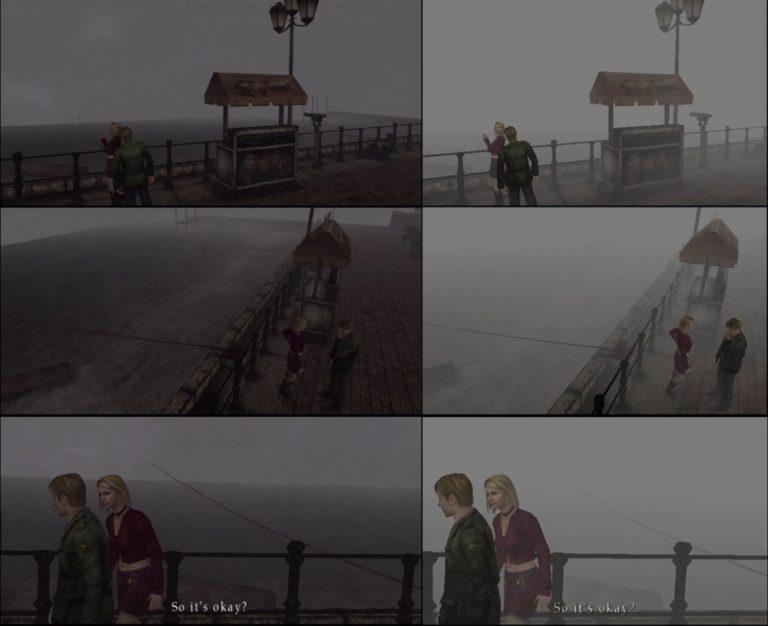
No Maria, It's not okay. It's disgusting!
Therefore, everyone who would like to feel nostalgic or to join for the first time perhaps the best gaming horror series can be advised to use PCSX2 in order to fully experience the original intention of the authors, instead of giving Konami money for outright hack.
Advantage # 2: old games in new quality
The most obvious advantage that emulators provide is the ability to play classic games on a widescreen monitor in Full HD or higher resolution with full-screen anti-aliasing, anisotropic texture filtering, surround sound, the ability to save at any time, and other attributes of modern gaming. After all, no matter how good the classic titles are, today it is physically painful to play most of them without changes, especially when it comes to early 3D, since high-quality pixel art is practically not subject to time.
With the help of emulators, you can pump even relatively recent releases. Take the same The Legend of Zelda: Breath of the Wild. Launched on CEMU, the game looks much better than on Switch, and if you own a powerful enough PC, you can play at a stable 60 FPS, which is an unattainable bar for a hybrid console.
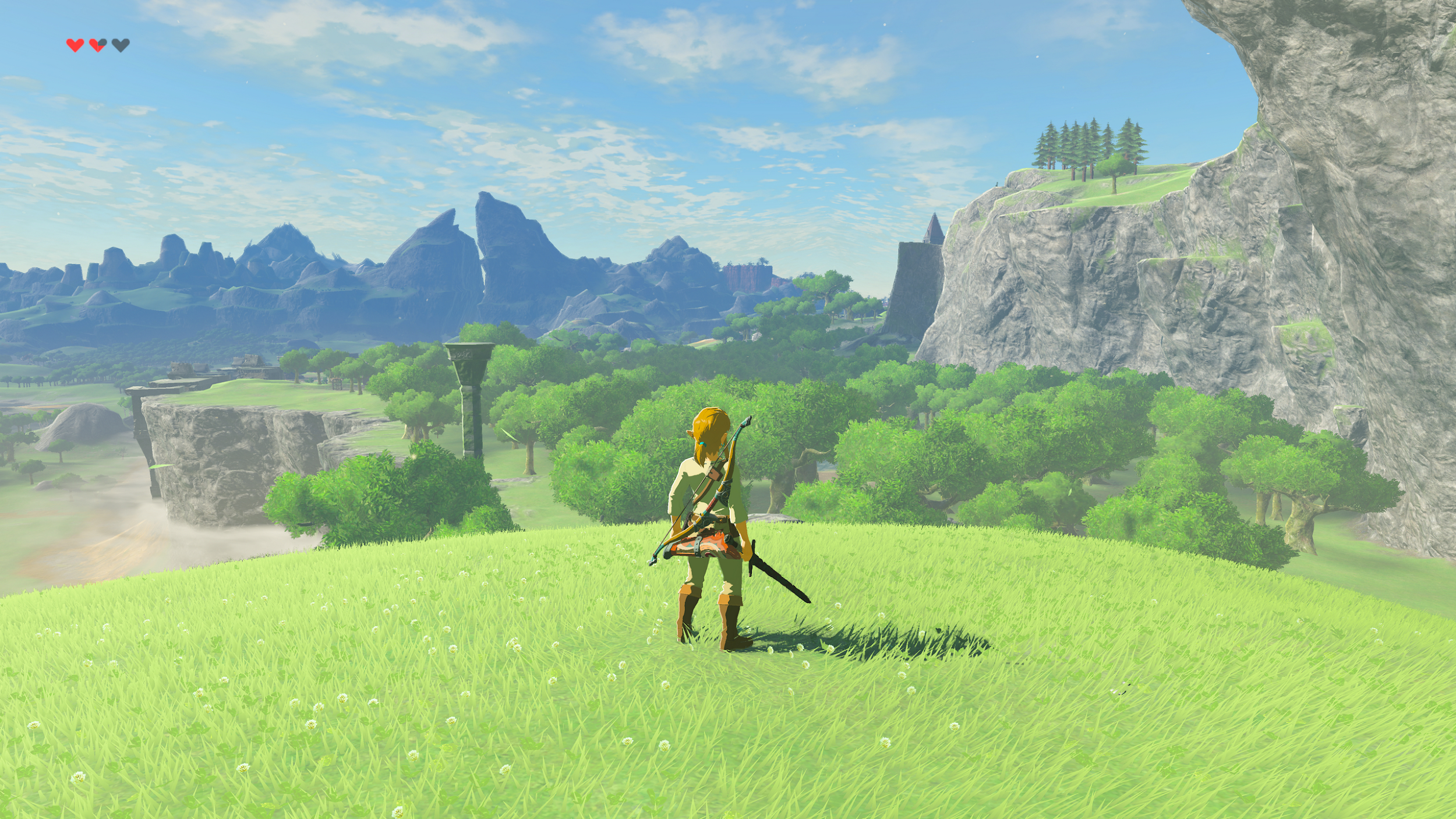
The Legend of Zelda: Breath of the Wild looks amazing on Cemu
If you want to try something really interesting, we recommend you pay attention to the 3DSen project. The fancy NES emulator came out this summer in Early Access on Steam. Its main feature is the "conversion" of 2D graphics in 3D (or, to be more precise, in 2.5D) on the fly. At the moment, support for 70 titles has been announced.

Micro Mages launched on 3DSen
Benefit # 3: More free space in the home
The volume of the game distribution kit for the NES did not exceed 40 KB, which is several tens of times less than the volume of this material saved in docx format. In this case, the dimensions of the cartridge with one game were 13.3 × 12 × 2 centimeters. A total of 715 games were released for the NES. Of course, not every one of them is worthy of attention, and many projects, no matter how good they are, may not please you. But even if you want to acquire a couple of hundred of these toys, you will need a shelf of very impressive dimensions to store them. Considering that the NES is just one of the many gaming systems released over the past 30 years, for a collection of games for consoles from the second to the eighth generation, you will have to rent a small warehouse or allocate an entire floor of a country house. This is exactly what Antonio Monteiro, a collector from Richmond, Texas, had to do.
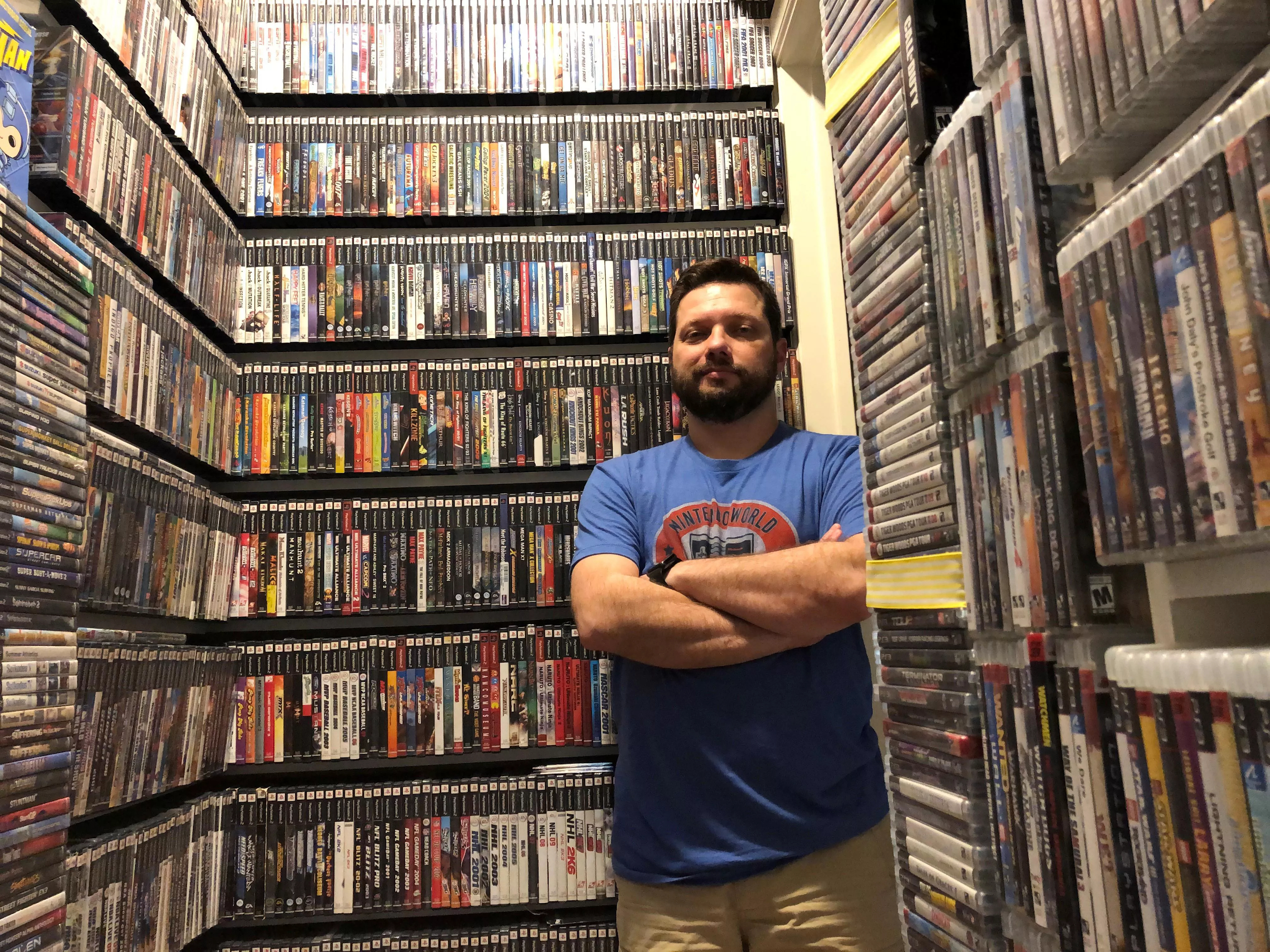
Antonio Monteiro and his collection of video games
Antonio is the owner of the largest collection of video games according to the Guinness Book of Records, with 20,139 titles. It took a total of 8 days of net time to accurately count all the cartridges, CDs, DVDs and Blue-Ray. Well, how much space all this stuff takes, you can estimate yourself.
If you do not have a passion for collecting, then emulators can help you save a lot of free space and money. Indeed, in order to ensure the safety of a collection like the one collected by Antonio for many years to come, you will have to take care of maintaining a constant indoor climate, which is also fraught with serious capital and operating costs.
Armed with a set of emulators instead of the consoles themselves and digital copies of distributions, you will save yourself from many problems associated with the placement and maintenance of such a collection, since modern data drives can provide a much higher storage density than archaic cartridges or optical disks. Take, for example, the external hard drive WD_BLACK P10, designed specifically for gamers.

The largest model with a capacity of 5 TB has dimensions of only 11.8 x 8.8 x 2 cm, which is even smaller than the cartridge for the Nintendo Entertainment System. At the same time, such a disc is capable of containing 125 million copies of NES games (almost 175 times more than in principle), more than 7 thousand games for Sony PlayStation (that is, almost all released projects) or 1200 games for PlayStation 2.
WD_BLACK P10 supports high-speed USB 3.1 Gen 1, and its performance reaches 140MB / s, which is comparable to the speed of internal HDDs. In addition, this model is adapted for many hours of work under load, which became possible primarily due to a well-thought-out passive cooling system: the case cover is made of metal and plays the role of a radiator, effectively removing heat from the 2.5-inch hard drive.
If the capabilities of P10 do not seem enough for you, we recommend paying attention to WD_BLACK D10.

If we again draw parallels with the NES cartridge, then this model will be slightly longer (19.5 cm versus 13.3 cm) and twice as thick (4.4 cm versus 2), which, however, is more than compensated for by its capacity and performance. WD_BLACK D10 can hold 8 TB of data (200 million NES games, 11.5 thousand PS1 games or 1900 PS2 games), and its performance reaches 250 MB / s, that is, identical to the top gaming HDD. Since there is a place for a cooler in the capacious case WD_BLACK D10, this hard drive can be operated even 24/7 without fear of overheating. As a pleasant bonus, it is worth mentioning the presence on the side panel of a pair of USB Type-A ports with a power of 7.5 W, due to which the drive can be used as a docking station for charging wireless peripherals (for example, a mouse, gamepad or headset).Thanks to all of the above, such a drive is able to fully satisfy the needs of not only a fan of retro games, but also a lover of modern large-budget projects.